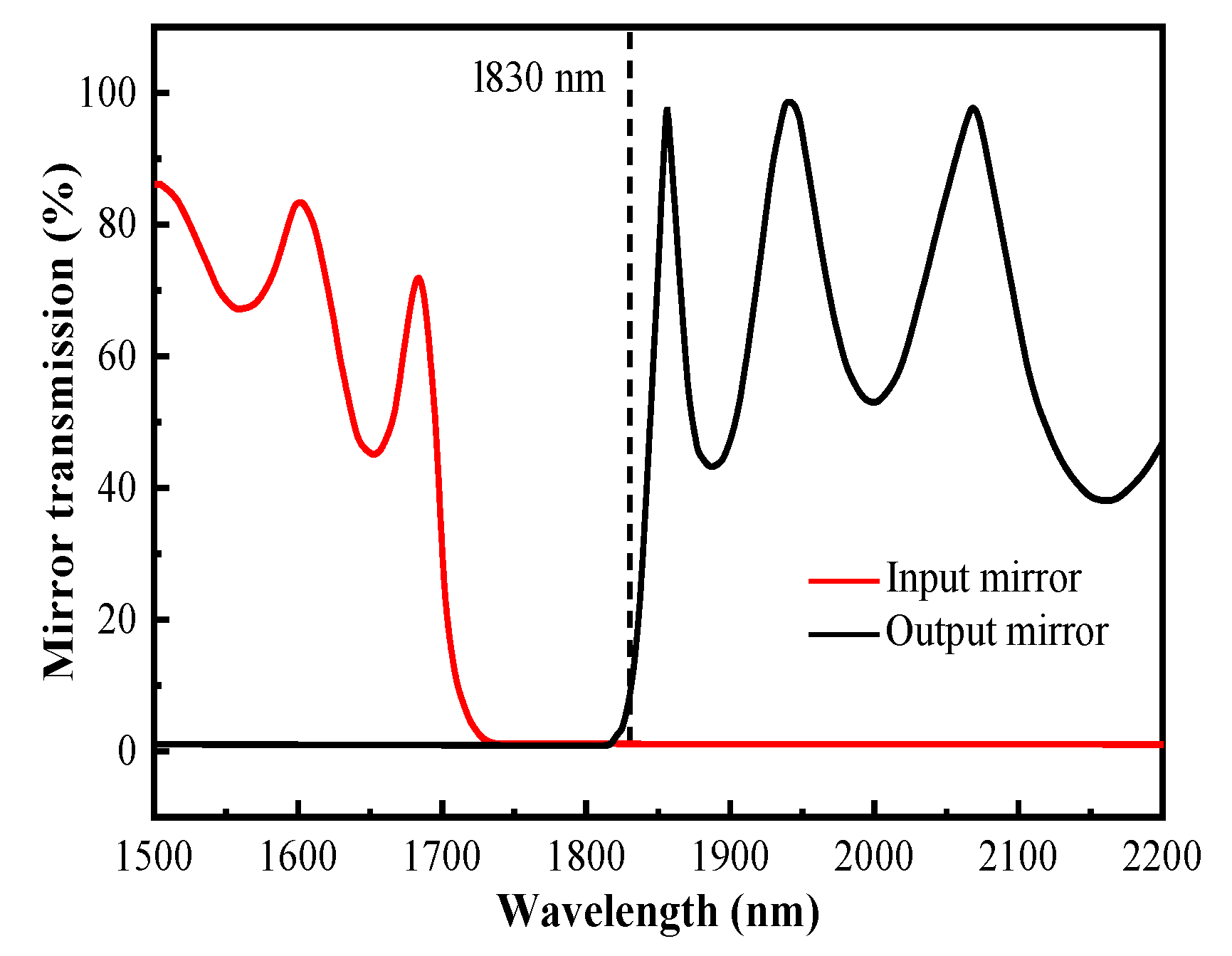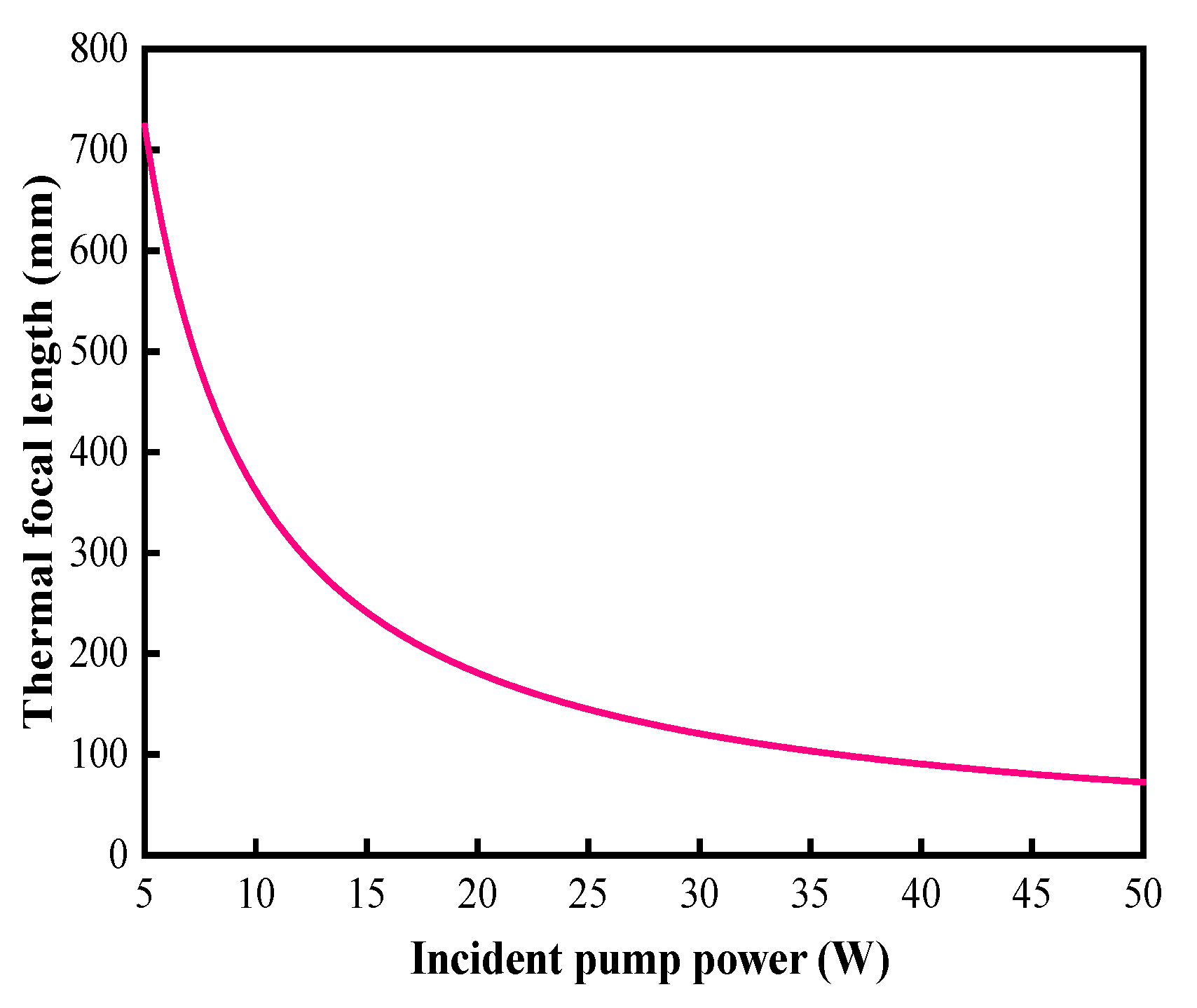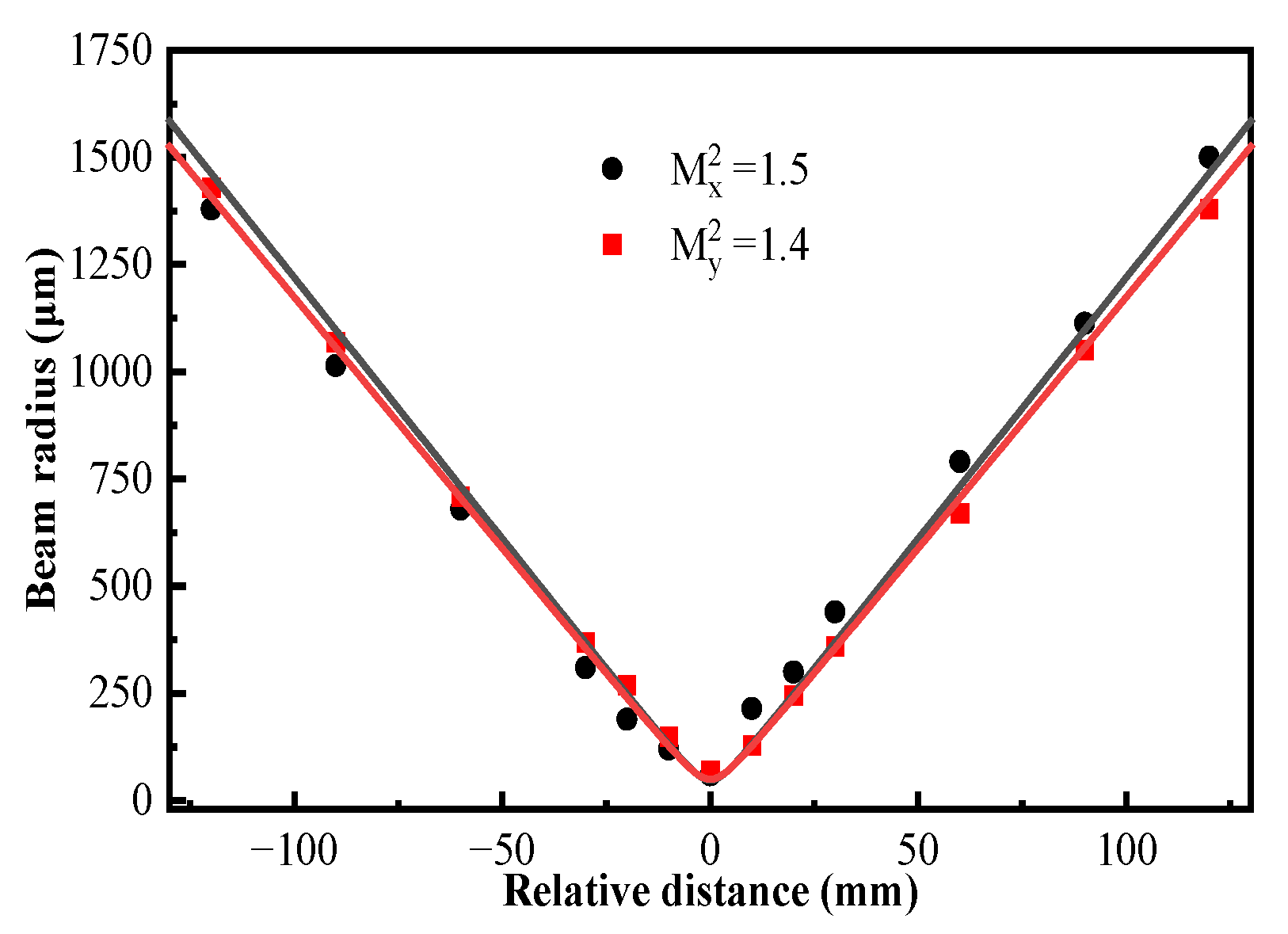High-Power Acoustic-Optical Q-Switched 1.83 µm Tm-Doped Bulk Laser
Abstract
:1. Introduction
2. Experimental Setup
3. Results and Discussions
4. Conclusions
Author Contributions
Funding
Institutional Review Board Statement
Informed Consent Statement
Data Availability Statement
Conflicts of Interest
References
- Sorokina, T. Cr2+-doped II-VI materials for laser and nonlinear optics. Opt. Mater. 2004, 26, 395. [Google Scholar] [CrossRef]
- Yu, H.; Wang, P.; Mi, J.; Zhou, X.; Pan, J.; Wang, H.; Xie, L.; Wang, W. 1.8-µm DBR Lasers with Over 11-nm Continous Wavelength Tuning Range for Multi-Species Gas Detection. In Proceedings of the 2017 Asia Communications and Photonics Conference (ACP), Guangzhou, China, 10–13 November 2017; p. Su2B.6. [Google Scholar]
- Leindecker, N.; Marandi, A.; Byer, R.L.; Vodopyanov, K.L.; Jiang, J.; Hartl, I.; Fermann, M.; Schunemann, P.G. Octave-spanning ultrafast OPO with 2.6–6.1 µm instantaneous bandwidth pumped by femtosecond Tm-fiber laser. Opt. Express 2012, 20, 7046. [Google Scholar] [CrossRef] [PubMed] [Green Version]
- Mingareev, I.; Weirauch, F.; Olowinsky, A.; Shah, L.; Kadwani, P.; Richardson, M. Welding of polymers using a 2 µm thulium fiber laser. Opt. Laser Technol. 2012, 44, 2095. [Google Scholar] [CrossRef]
- Wang, Y.; Fleming, F.; Mccracken, R.A.; Liebig, C.; Mcdaniel, S.; Cook, G.; Laporta, P.; Kar, A.K.; Galzerano, G. Hot-isostatic-pressed Cr:ZnSe ultrafast laser at 2.4 μm. Opt. Laser Technol. 2022, 154, 108300. [Google Scholar]
- Lan, J.; Cui, Q.; Wang, Y.; Xu, B.; Xu, H.; Cai, Z. Single-mode oscillation of a diode-pumped Nd:YAG microchip laser at 1835 nm. Opt. Mater. 2016, 60, 590. [Google Scholar] [CrossRef]
- Daniel, J.M.O.; Simakov, N.; Tokurakawa, M.; Ibsen, M.; Clarkson, W.A. Ultra-short wavelength operation of a thulium fibre laser in the 1660–1750 nm wavelength band. Opt. Express 2015, 23, 18269. [Google Scholar] [CrossRef]
- Bai, F.; Wang, Q.; Liu, Z.; Zhang, X.; Sun, W.; Wan, X.; Li, P.; Jin, G.; Zhang, H. Efficient 1.8 µm KTiOPO4 optical parametric oscillator pumped within an Nd:YAG/SrWO4 Raman laser. Opt. Lett. 2011, 36, 813. [Google Scholar] [CrossRef]
- Zhu, H.; Guo, J.; Duan, Y.; Zhang, J.; Zhang, Y.; Xu, C.; Wang, H.; Fan, D. Efficient 1.7 µm light source based on KTA-OPO derived by Nd:YVO4 self-Raman laser. Opt. Lett. 2018, 43, 345. [Google Scholar] [CrossRef]
- Chen, H.; Huang, H.; Wang, S.; Shen, D. A high-peak-power orthogonally-polarized multi-wavelength laser at 1.6-1.7 µm based on the cascaded nonlinear optical frequency conversion. Opt. Express 2019, 27, 24857. [Google Scholar]
- Lei, P.; Ding, X.; Bai, Y.; Yu, X.; Jiang, G.; Li, T.; Sun, B.; Zhang, X.; Li, X.; Wu, L.; et al. 1.8-μm MgO: PPLN optical parametric oscillator pumped by Nd: YVO4/YVO4 2nd-Stokes Raman laser. Results Phys. 2021, 29, 104703. [Google Scholar]
- Wallace, R. Oscillation of the 1.833-µ line in Nd3+:YAG. IEEE J. Quantum Elect. 1971, 7, 203. [Google Scholar] [CrossRef]
- Cai, Y.; Xu, B.; Zhang, Y.; Tian, Q.; Xu, X.; Song, Q.; Li, D.; Xu, J.; Buchvarov, I. High power and energy generation in a Nd:YAG single-crystal fiber laser at 1834 nm. Photon. Res. 2019, 7, 162. [Google Scholar] [CrossRef]
- Zhou, Z.; Wang, Y.; Xu, B.; Xu, H.; Cai, Z.; Xu, X.; Li, D.; Xu, J. Crystal and ceramic lasers at 1.83 μm operating on 4F3/2 → 4I15/2 transition. Opt. Mater. 2017, 70, 11. [Google Scholar] [CrossRef] [Green Version]
- Zhang, H.; Sun, D.; Luo, J.; Quan, C.; Chen, M.; Hu, L.; Han, Z.; Dong, K. Effect of Tm3+ concentration on structure, defect, and spectral properties of Tm: YAP crystals. Appl. Phys. A 2021, 127, 730. [Google Scholar] [CrossRef]
- Li, Y.; Wang, Y.; Ju, Y. Comparative study of LD-pumped Tm:YAG and Tim:LuAG lasers. Laser Phys. 2008, 18, 722. [Google Scholar] [CrossRef]
- Luan, C.; Yang, K.; Zhao, J.; Zhao, S.; Qiao, W.; Li, T.; Feng, T.; Liu, C.; Qiao, J.; Zheng, L.; et al. Dual-loss-modulated Q-switched Tm:LuAG laser with AOM and monolayer graphene. Appl. Optics 2015, 54, 8024. [Google Scholar] [CrossRef]
- Li, G.; Liu, H.; Lu, F.; Wen, X.; Gu, Y.; Wang, Y. Analysis on preferential free running laser wavelength and performance modeling of Tm3+-doped YAP and YLF. Appl. Optics 2014, 53, 4987. [Google Scholar] [CrossRef]
- Sulc, J.; Jelinkova, H.; Koranda, P.; Cerny, P.; Jabczynski, J.; Zendzian, W.; Kwiatkowski, J.; Urata, Y.; Higuchi, M. Comparison of tunable lasers based on diode pumped Tm-doped crystals. In Proceedings of the 16th Polish-slovak-czech Optical Conference on Wave and Quantum Aspects of Contemporary Optics, Polanica Zdroj, Poland, 18–20 September 2008; Volume 7141, p. 71410C. [Google Scholar]
- Lan, J.; Xu, B.; Zhang, Y.; Xu, H.; Cai, Z.; Xu, X.; Li, D.; Soulard, R.; Moncorgé, R.; Xu, J. Tunable and passively Q-switched laser operation of Tm:CaYAlO4 between 1848 nm and 1876 nm. Opt. Laser Technol. 2019, 109, 33–38. [Google Scholar] [CrossRef]
- Na, Q.; Xu, C.; Huang, Z.; He, M.; Chen, Z.; Xu, T.; Wang, L.; Yan, P.; Li, Y.; Luo, S.; et al. High-power and high-efficiency short wavelength operation of a Tm:YLF laser at 1.83 µm. Opt. Lett. 2019, 44, 4403. [Google Scholar] [CrossRef]
- Na, Q.; Xu, C.; Chen, H.; Yin, J.; Wang, J.; Yu, Y.; Yang, J.; Wang, L.; Yan, P.; Ruan, S. Continuous-wave and mode-locking operation of Tm:YAP lasers near 1.8 μm. Opt. Laser Technol. 2021, 142, 107225. [Google Scholar] [CrossRef]
- Walsh, B.M.; Barnes, N.P.; Di Bartolo, B. Branching ratios, cross sections, and radiative lifetimes of rare earth ions in solids: Application to Tm3+ and Ho3+ ions in LiYF4. J. Appl. Phys. 1998, 83, 2772. [Google Scholar] [CrossRef]
- Guo, L.; Yang, Y.L.; Wang, R.H.; Zhang, B.T.; Li, T.; Zhao, S.Z.; He, J.L.; Yang, K.J. Experimental and Theoretical Study of an Actively Q-Switched Tm:YLF Laser with an Acousto-Optic Modulator. Molecules 2021, 26, 7324. [Google Scholar] [CrossRef] [PubMed]
- Song, F.; Zhang, C.; Ding, X.; Xu, J.; Zhang, G.; Leigh, M.; Peyghambarian, N. Determination of thermal focal length and pumping radius in gain medium in laser diode-pumped Nd:YVO4 laser. Appl. Phys. Lett. 2002, 81, 2145. [Google Scholar] [CrossRef]
- Wu, Z.; Wang, X.; Chen, G.; Bai, J.; Ren, Y.; Zhao, W.; Hou, X. Experimental study of mode matching of double-end-pumped solid-stated lasers. Acta Photonica Sin. 2002, 31, 223. [Google Scholar]
- Sheintop, U.; Perez, E.; Noach, S. Narrow bandwidth tunable watt level Tm:YAP laser using two etalons. In Proceedings of the 6th International Conference on Photonics, Optics and Laser Technology, Madeira, Portugal, 25–27 January 2018; pp. 303–307. [Google Scholar]
- Liu, X.; Yang, K.; Zhao, S.; Li, T.; Li, G.; Li, D.; Guo, X.; Zhao, B.; Zheng, L.; Su, L.; et al. Kilo-hertz-level Q-switched laser characteristics of a Tm,Y:CaF2 crystal. Opt. Mater. Express 2017, 7, 4352. [Google Scholar] [CrossRef]
- Feng, T.; Yang, K.; Zhao, S.; Qiao, W.; Zhao, J.; Li, D.; Li, G.; Li, T.; Zheng, L.; Xu, J. An acoustic-optically Q-switched Tm:SSO laser at 2 μm. Opt. Commun. 2015, 336, 20. [Google Scholar] [CrossRef]










| Length of Tm:YLF/mm | Output Wavelength/nm | |
|---|---|---|
| Theory | Experiment | |
| 10 | 1830 | 1830 |
| 12 | 1830 | 1828 |
| 15 | 1830 | 1828 |
| 22 | 1880 | 1887 |
| 25 | 1880 | 1886 |
Disclaimer/Publisher’s Note: The statements, opinions and data contained in all publications are solely those of the individual author(s) and contributor(s) and not of MDPI and/or the editor(s). MDPI and/or the editor(s) disclaim responsibility for any injury to people or property resulting from any ideas, methods, instructions or products referred to in the content. |
© 2023 by the authors. Licensee MDPI, Basel, Switzerland. This article is an open access article distributed under the terms and conditions of the Creative Commons Attribution (CC BY) license (https://creativecommons.org/licenses/by/4.0/).
Share and Cite
Lv, G.; Guo, L.; Xu, H.; Dou, X.-A.; Ye, Q.; Kong, H.; Yang, Y.; Wen, J.; Bian, J.; Yang, K. High-Power Acoustic-Optical Q-Switched 1.83 µm Tm-Doped Bulk Laser. Photonics 2023, 10, 876. https://doi.org/10.3390/photonics10080876
Lv G, Guo L, Xu H, Dou X-A, Ye Q, Kong H, Yang Y, Wen J, Bian J, Yang K. High-Power Acoustic-Optical Q-Switched 1.83 µm Tm-Doped Bulk Laser. Photonics. 2023; 10(8):876. https://doi.org/10.3390/photonics10080876
Chicago/Turabian StyleLv, Guorui, Lei Guo, Haiping Xu, Xian-An Dou, Qing Ye, Hui Kong, Yaling Yang, Jiaqi Wen, Jintian Bian, and Kejian Yang. 2023. "High-Power Acoustic-Optical Q-Switched 1.83 µm Tm-Doped Bulk Laser" Photonics 10, no. 8: 876. https://doi.org/10.3390/photonics10080876
APA StyleLv, G., Guo, L., Xu, H., Dou, X.-A., Ye, Q., Kong, H., Yang, Y., Wen, J., Bian, J., & Yang, K. (2023). High-Power Acoustic-Optical Q-Switched 1.83 µm Tm-Doped Bulk Laser. Photonics, 10(8), 876. https://doi.org/10.3390/photonics10080876






